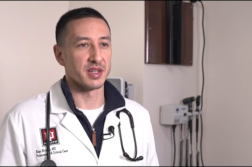PITTSBURGH, Pa. (Ivanhoe Newswire)— Chronic obstructive pulmonary disease, or COPD, is a group of diseases including emphysema and bronchitis that cause serious or life-threatening breathing problems. Rescue inhalers or steroids can lessen symptoms but aren’t a cure. Now, there’s an experimental procedure that may help patients breathe better when nothing else is working. Targeted Lung Denervation
James Irwin used to work physical jobs like welding and construction. Then on weekends, he and girlfriend Shadley would unwind at amusement parks. Wooden coasters were his favorite.
“You know, it takes your breath away no matter what and my breath is already gone,” shared James.
Two years ago, James started getting winded walking more than a few feet. Nothing worked to ease the symptoms of COPD. That’s when Dr. Frank Sciurba approached James about a trial of a new procedure called targeted lung denervation, or TLD. Research has shown that in COPD patients, the vagus nerve is overstimulated, causing extra mucus production. During TLD, surgeons send a small scope through the mouth into the lungs, a balloon inflates the airway, and a small electrode delivers radiofrequency.
“That heat signal occurs right on the surface of the bronchial tube where the vagus nerve runs,” explained Frank Sciurba, MD, pulmonologist and professor of medicine at University of Pittsburgh Medical Center.
Doctors rotate the catheter and repeat the procedure three times to interrupt the nerve signal, decreasing mucus.
“I think to have another option where we can give them more good days, to avoid the healthcare system, I think is potentially huge,” revealed Dr. Sciurba.
“I’m not coughing as much as I used to. I’m not having as much phlegm or mucus like that,” James recalled.
Making it easier to enjoy simple things, like time outdoors with Shadley.
Patients were randomly selected to receive TLD as part of the trial. James says he’s not sure if he received the ablation, but knows he feels better now than before. Dr. Sciurba says after 12 months, patients who were in the randomized arm of the trial and did not receive TLD would be eligible to get the procedure. While patients do have an overnight stay right now, Dr. Sciurba says TLD can be performed as an outpatient procedure- requiring no hospital stay.
Contributors to this news report include: Cyndy McGrath, Executive & Field Producer; Kirk Manson, Videographer; Roque Correa, Editor.
To receive a free weekly e-mail on Medical Breakthroughs from Ivanhoe, sign up at: http://www.ivanhoe.com/ftk
Sources:
https://www.lung.org/lung-health-diseases/lung-disease-lookup/copd/learn-about-copd
MEDICAL BREAKTHROUGHS
RESEARCH SUMMARY
TOPIC: COPD: TARGETED LUNG DENERVATION ZAPS NERVES TO BREATHE BETTER!
REPORT: MB #4880
BACKGROUND: COPD is a group of lung diseases that make it hard to breathe. Normally, the airways and air sacs in the lungs are stretchy and when you breathe in, they bring air to the air sacs and fill up like a small balloon. When you breathe out, the air sacs deflate. If you have COPD, less air flows in and out of the airways because the airways and air sacs in the lungs become less elastic; the walls between many of the air sacs are destroyed; the walls of the airways become thick and inflamed; or the airways make more mucus than usual and can become clogged. There are two types of COPD. Emphysema affects the air sacs in the lungs, as well as the walls between them, and chronic bronchitis, in which the lining of the airways is constantly irritated and inflamed causing it to swell and make mucus.
(Source: https://medlineplus.gov/copd.html)
CAUSES AND SYMPTOMS: Long-term exposure to irritants that damage the lungs and airways is usually the cause of COPD. In the United States, cigarette smoke is the main cause, along with pipe, cigar, and other types of tobacco smoke. Even secondhand smoke, air pollution, and chemical fumes or dusts from the environment, when inhaled, can lead to COPD. You may have no symptoms or mild symptoms at first. As the disease gets worse, your symptoms become more severe. Some of these symptoms include: frequent coughing or a cough that produces mucus; wheezing or a whistling sound when you breathe; shortness of breath; or tightness in your chest. Some people with COPD get frequent respiratory infections such as colds and the flu. In severe cases, COPD can cause weight loss, weakness in your lower muscles, and swelling in your ankles, feet, or legs.
(Source: https://medlineplus.gov/copd.html)
NEW VALVE THERAPY FOR COPD: Current COPD treatments include pulmonary rehabilitation, bronchodilators and corticosteroids, and lung volume reduction surgery. However, there is a new option that has been approved by the FDA called the Zephyr Valve. It offers hope for patients with advanced disease. During the procedure, stents are placed into the patients’ airways leading to the most diseased parts of the lungs using a bronchoscope, closing them off. “What we’re trying to do with the valves, which are extremely small, is put them inside the diseased part of the lung, in order to block the air from going in,” explained Dr. Jose De Cardenas, clinical assistant professor of internal medicine at UM Medical School. As a result, the non-diseased portion can expand and relieve the pressure on the diaphragm, allowing patients to breathe better.
FOR MORE INFORMATION ON THIS REPORT, PLEASE CONTACT:
TAYLOR ANDRES
(412) 592-7406
If this story or any other Ivanhoe story has impacted your life or prompted you or someone you know to seek or change treatments, please let us know by contacting Marjorie Bekaert Thomas at mthomas@ivanhoe.com




